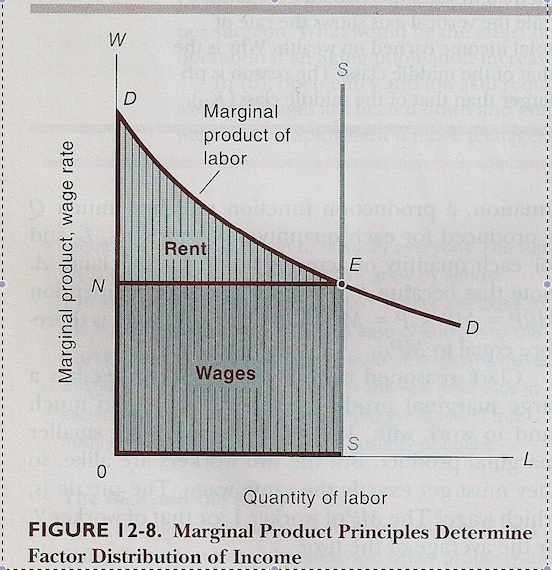Democracy Against Capitalism: Neoliberalism
I’m writing Ellen Meiksins Wood’s book Democracy Against Capitalism as part of my general project of understanding the origins of neoliberalism and its sudden takeover as the sole way of understanding the economy and society. Marxists use the metaphor of base and superstructure, the production base, and the cultural, ideological, legal superstructure. See this post, which defines these and other terms used in this post. Neoliberalism is an ideology, a set of ideas that we use to understand the world. Therefore it is part of the superstructure.
Wood says that no system is pure capitalism because there are always other modes of production in every society. We say we live in a capitalist society because the capitalist mode of production is the most widespread. I use the definition from Wikipedia:
The capitalist mode of production is characterized by private ownership of the means of production, extraction of surplus value by the owning class for the purpose of capital accumulation, wage-based labour and—at least as far as commodities are concerned—being market-based.
This article is very much worth reading. Wood explains the relevance of Marxism today:
… we’re living in a moment when, for the first time, capitalism has become a truly universal system. It’s universal not only in the sense that it’s global, not only in the sense that just about every economic actor in the world today is operating according to the logic of capitalism, and even those on the outermost periphery of the capitalist economy are, in one way or another, subject to that logic. Capitalism is universal also in the sense that its logic—the logic of accumulation, commodification, profit-maximization, competition—has penetrated just about every aspect of human life and nature itself, in ways that weren’t even true of so-called advanced capitalist countries as recently as two or three decades ago. So Marx is more relevant than ever, because he, more effectively than any other human being then or now, devoted his life to explaining the systemic logic of capitalism.
For me, at least, the bold-face sentence sounds exactly like a brief description of neoliberalism. The capitalist mode of production is driven by the logic of accumulation, commodification, profit-maximization and competition. We are at an historic high for those forces, which today reach farther into our lives than ever before.
Wood points out that earlier Marxists confronted societies where the capitalist mode of production had not taken over, as in the Russian Revolution, where there were masses of peasants living in a pre-industrial mode of production. The same situation confronted Mao in China. Marx, she points out, studied an early form of capitalism in England where it had suddenly become the most widespread mode of production but where there were still large pockets of other modes of production. She argues that as capitalism matured in England, it depended on imperialism and colonialism, which operated in non-capitalist forms. This argument is also made by Polanyi in The Great Transformation and Arendt in The Origins of Totalitarianism in great detail (I discussed these here and here.) That is not the case any more. Capitalism is everywhere.
This explanation helps answer the question about the rise of neoliberalism. It’s not a new thing, it’s simply the form of capitalism that arises from the logical working out of capitalism in historical terms. In this view, the ideology comes into being to justify the form into which capitalism is evolving.
This isn’t to deny agency to the people creating the ideology and pushing it to its dominant position or to the people driving the changes in capitalism. There are always choices, choices to replace capitalism or to control it.
Wood says ideology changes in response to the changes in the social relations created by the capitalist mode of production, which is the way Marxists typically understand the relation between base and superstructure. She puts less emphasis on the individuals who create the ideology, and little emphasis on the people who create the changes in the economic base. She says that something like the current form of capitalism was bound to happen whether the ideology changed or not, and irrespective of who was in the capitalist class.
Wood says that no society is pure, so that the capitalist mode of production is just one of several modes of production. Even in more mature capitalist societies, some workers are not separated from the means of production; they own their own tools, or have a small capital, or a trade that is independent of large pools of capital. They and some others produce goods and services not just for money but also for for other reasons. In its early stages, capitalism can expand into other societies which have not adopted the capitalist mode of production. More recently, those avenues are closing off, and capitalism is expanding by assimilating more and more of those who have until now avoided it. As an example, look at doctors. For decades they owned their own practices and their own tools and offices. Now they are being sucked into the medical industrial form in which they own nothing but their labor, just like factory workers. That changes the social relations between doctors and patients, and the relations between people and the medical system.
Nobody resists. The rich and powerful benefit. Social structures change. A new ideology, neoliberalism, arises to explain and justify this new set of social relations, and to justify further change. The capitalists merge and consolidate, they buy up more small artisans and producers, they acquire dominance over formerly independent professionals, they set up institutions to replace socially owned and controlled sectors like hospitals, jails and schools, and begin to replace government whenever possible. This is a form of domination we used to describe with perjoratives, but now most of our elites are on board.
In this post I discuss the rise of neoliberalism from the perspective gained reading Culture and Power: The Sociology of Pierre Bourdier. In my telling, Bourdieu emphasizes the role of the rich and powerful in the rise of neoliberalism. The important factor is a relatively small number of members of the dominant class, the group which benefits most from exploitation, domination and appropriation. They are able to impose their views on the producers through what Bourdieu calls symbolic violence; a term that is probably more rhetorical than descriptive. Following Page and Winter on oligarchy in democracy, we can add that most members of the dominant class do not interfere with those who move to effectuate their common purposes of wealth protection, wealth enhancement and absolute freedom to deploy their wealth.
The difference is that in Wood’s telling, the current form of capitalism is a logical evolution from prior forms, while in my telling, neoliberalism is imposed from above. Both Wood and Bourdieu are trying to understand how society has changed with a view to helping activists identify ways to effect change. For Wood, the problem is centered on the capitalist mode of production. Social change will come from changing to some other mode of production. For Bourdieu, the problem is the rich and powerful people who are able to dominate the discourse and impose on the rest of us. For him a primary direction for change is to reduce their power to dominate.
Or, we could do both.


